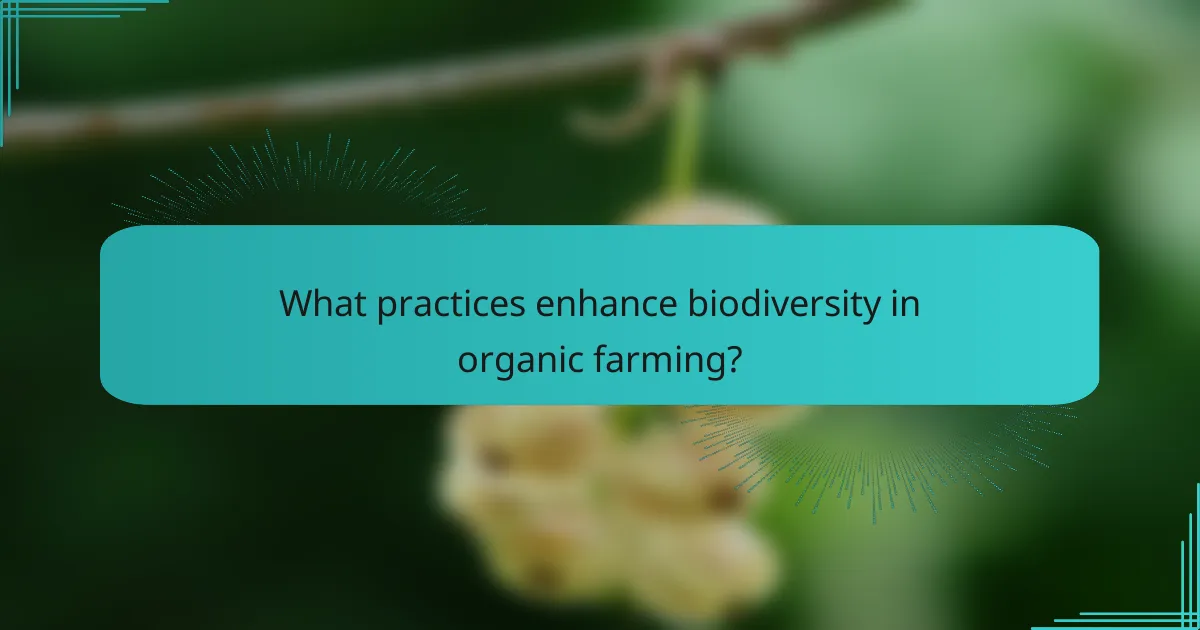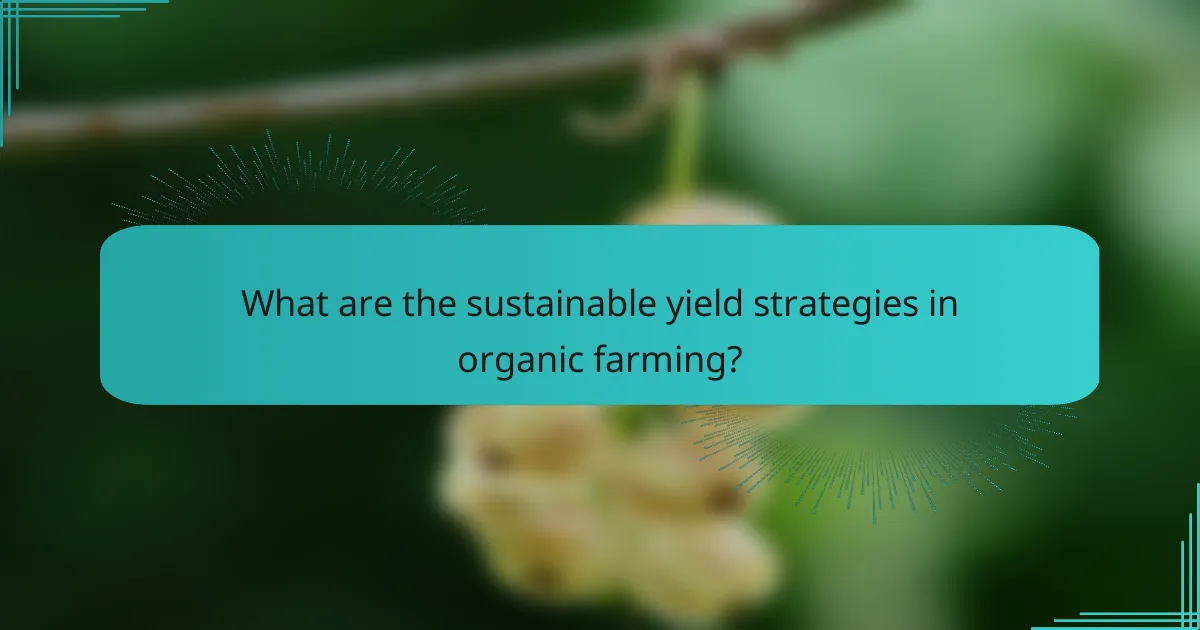Organic farming practices play a crucial role in enhancing soil health, promoting biodiversity, and achieving sustainable yields. By focusing on natural processes and ecological interactions, these methods build resilient ecosystems that support both crop production and environmental sustainability. Through the implementation of diverse agricultural strategies, organic farming not only improves soil fertility but also fosters a balanced ecosystem that can withstand pests and diseases.

How can organic farming improve soil health in Australia?
Organic farming enhances soil health in Australia by promoting practices that increase soil fertility, structure, and biodiversity. These methods focus on natural processes to build a resilient ecosystem that supports sustainable agricultural yields.
Cover cropping
Cover cropping involves planting specific crops during off-seasons to protect and enrich the soil. These crops, such as legumes or grasses, prevent erosion, suppress weeds, and enhance soil structure by adding organic matter when tilled back into the soil.
In Australia, farmers can choose cover crops suited to their climate, such as oats or vetch, which can improve nitrogen levels and overall soil health. Timing is crucial; planting should coincide with fallow periods to maximize benefits.
Composting
Composting is the process of recycling organic waste into nutrient-rich soil amendments. By combining kitchen scraps, yard waste, and other organic materials, farmers can create compost that boosts soil fertility and microbial activity.
In Australia, maintaining a balanced compost pile with a mix of green (nitrogen-rich) and brown (carbon-rich) materials is essential. Regular turning and monitoring moisture levels will ensure effective decomposition and high-quality compost.
Crop rotation
Crop rotation involves alternating different crops in the same field across seasons to improve soil health and reduce pest and disease pressure. This practice helps maintain nutrient balance and prevents the depletion of specific soil nutrients.
A typical rotation in Australia might include legumes followed by cereals, which can enhance nitrogen levels and soil structure. Planning rotations based on crop families can optimize benefits and reduce reliance on chemical fertilizers.
Reduced tillage
Reduced tillage minimizes soil disturbance, preserving soil structure and microbial life. This practice can lead to improved water retention and reduced erosion, which are vital for maintaining soil health in Australian conditions.
Farmers should consider using no-till or minimum-till methods, which can be particularly beneficial in dry regions. Implementing this approach requires careful planning of planting and weed management strategies to ensure success.
Organic amendments
Organic amendments, such as manure, bone meal, or green manure, are added to the soil to enhance its nutrient content and biological activity. These materials improve soil fertility and structure, contributing to overall soil health.
In Australia, sourcing quality organic amendments is crucial. Farmers should ensure that these materials are well-composted and free from pathogens to avoid introducing harmful organisms into the soil.

What practices enhance biodiversity in organic farming?
Enhancing biodiversity in organic farming involves implementing practices that promote a variety of species and ecological interactions. These methods not only improve soil health but also contribute to sustainable yields and resilience against pests and diseases.
Polyculture systems
Polyculture systems involve growing multiple crops in the same space, which can lead to increased biodiversity. This practice helps in pest management, as diverse plant species can attract beneficial insects and reduce the likelihood of crop failure.
Farmers can implement polyculture by intercropping or rotating different species. For example, planting legumes alongside cereals can enhance soil fertility and provide better yields than monoculture systems.
Agroforestry
Agroforestry integrates trees and shrubs into agricultural landscapes, promoting biodiversity and improving ecosystem services. This practice can enhance soil quality, provide habitats for wildlife, and offer additional income sources through timber or fruit production.
Farmers should consider native tree species that are well-adapted to local conditions. Establishing tree rows or windbreaks can also protect crops from wind and erosion while fostering a diverse ecosystem.
Wildlife corridors
Wildlife corridors are strips of natural habitat that connect isolated patches of land, allowing species to move freely and maintain genetic diversity. These corridors can be crucial for pollinators and other beneficial organisms that support organic farming.
Creating wildlife corridors can involve planting native vegetation along field edges or maintaining existing hedgerows. This practice not only enhances biodiversity but also contributes to pest control and pollination services.
Beneficial insect habitats
Providing habitats for beneficial insects, such as pollinators and natural pest predators, is essential for enhancing biodiversity in organic farming. This can be achieved by planting flowering plants that bloom at different times throughout the growing season.
Farmers can create insect habitats by incorporating wildflower strips or maintaining areas of native vegetation. Avoiding pesticides in these zones will help sustain healthy populations of beneficial insects, ultimately improving crop yields.

What are the sustainable yield strategies in organic farming?
Sustainable yield strategies in organic farming focus on maximizing crop production while maintaining ecological balance and soil health. These strategies include practices that enhance biodiversity, improve soil fertility, and ensure efficient resource use.
Integrated pest management
Integrated pest management (IPM) is a holistic approach that combines biological, cultural, physical, and chemical tools to manage pests sustainably. By monitoring pest populations and using natural predators or resistant crop varieties, farmers can minimize chemical pesticide use, which is crucial in organic farming.
Key steps in IPM include regular field scouting, identifying pest thresholds, and employing non-chemical control methods first. For example, introducing beneficial insects like ladybugs can help control aphid populations without harming the environment.
Organic fertilizers
Organic fertilizers, such as compost, manure, and green manures, enhance soil fertility and structure while providing essential nutrients to crops. These fertilizers improve microbial activity in the soil, which is vital for nutrient cycling and plant health.
Farmers should consider applying organic fertilizers based on soil tests to determine nutrient needs. A common practice is to use compost at a rate of 2-5 tons per acre, which can significantly boost soil organic matter and overall fertility.
Water conservation techniques
Water conservation techniques in organic farming are essential for sustainable yields, especially in regions prone to drought. Methods such as drip irrigation and rainwater harvesting help optimize water use and reduce waste.
Farmers can implement practices like mulching to retain soil moisture and reduce evaporation. Additionally, using cover crops can improve soil structure and enhance water infiltration, making it easier for crops to access moisture during dry periods.

What are the prerequisites for starting organic farming?
Starting organic farming requires a solid understanding of soil health, local regulations, and market dynamics. These prerequisites ensure that your farming practices are sustainable and compliant while meeting consumer demand.
Soil testing
Soil testing is essential for assessing the nutrient content and health of your land. Conduct tests to determine pH levels, organic matter, and nutrient deficiencies, which will guide your amendments and crop selection.
Consider testing your soil at least once a year, especially before planting. This helps you tailor your organic practices, such as composting or cover cropping, to improve soil fertility effectively.
Understanding local regulations
Familiarizing yourself with local organic farming regulations is crucial for compliance and certification. Each country has specific standards, such as the USDA Organic in the United States or EU Organic in Europe, that dictate what practices are permissible.
Research the certification process and any necessary documentation required to market your products as organic. Non-compliance can lead to penalties or loss of market access.
Market research
Conducting thorough market research helps you understand consumer preferences and pricing trends for organic products. Identify your target market, whether local farmers’ markets, grocery stores, or online platforms.
Analyze competitors and their offerings to find gaps in the market. This insight will inform your crop choices and marketing strategies, ensuring you meet demand effectively.


